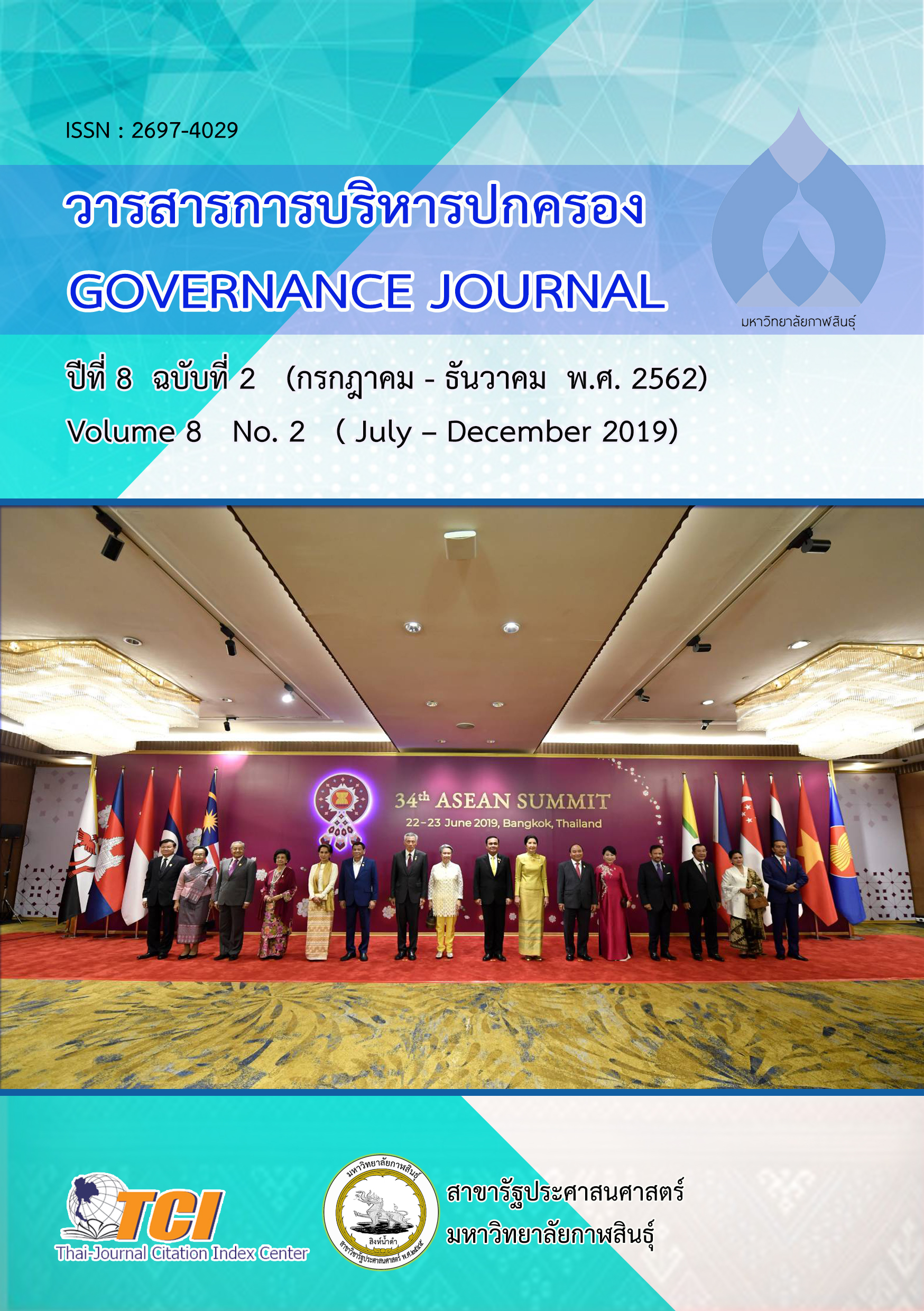หญิงขายบริการทางเพศต่างชาติในประเทศไทย : การสำรวจและนัยเชิงนโยบายด้านสุขภาพ
DOI:
https://doi.org/10.14456/gjl.2019.27คำสำคัญ:
หญิงขายบริการทางเพศต่างชาติ; แรงจูงใจ; การใช้ถุงยางอนามัยบทคัดย่อ
บทคัดย่อ
บทความวิจัยนี้มีวัตถุประสงค์ของการศึกษาได้แก่ 1) เพื่อศึกษาหญิงขายบริการทางเพศต่างชาติในประเทศไทยว่าเกิดจากการค้ามนุษย์หรือสมัครใจมาเอง 2) เพื่อศึกษาแรงจูงใจในการขายบริการทางเพศของหญิงต่างชาติในประเทศไทย 3) เพื่อศึกษาการใช้ถุงยางอนามัยของคนกลุ่มนี้ การศึกษาอาศัยการวิจัยเชิงคุณภาพและเชิงปริมาณ ตัวอย่างเป็นหญิงขายบริการทางเพศต่างชาติจากสามจังหวัดได้แก่กรุงเทพมหานคร ฉะเชิงเทรา และสงขลา การสำรวจทำระหว่างปี 2554-55 การวิจัยเชิงปริมาณใช้การสำรวจโดยแบบสอบถามหญิงขายบริการทางเพศต่างชาติจำนวน 278 คน การวิจัยเชิงคุณภาพใช้การสัมภาษณ์เจาะลึกหญิงขายบริการทางเพศต่างชาติจำนวน 32 คน ทั้งหมดมาจากประเทศลาว พม่า กัมพูชา จีน และเวียดนาม ผลการศึกษาพบว่าปัจจัยทางเศรษฐกิจเป็นปัจจัยสำคัญที่ทำให้หญิงต่างชาติเหล่านี้ตัดสินใจมาขายบริการทางเพศ ดังนั้นจึงไม่จำเป็นเสมอไปว่าหญิงขายบริการเหล่านี้จะถูกบังคับให้มาขายบริการ โดยหญิงขายบริการมีรายได้มากพอที่จะส่งเงินกลับไปให้ครอบครัวที่ประเทศของตนเองและมีเวลาการทำงานที่ยืดหยุ่น ส่วนมากจะมาทำงานตั้งแต่อายุยังน้อยและวางแผนที่จะเลิกขายบริการทางเพศเมื่อมีเงินสะสมมากเพียงพอที่จะนำไปใช้ในประเทศของตนเองในอนาคต การศึกษาพบว่า 1 ใน 6 ของหญิงขายบริการทางเพศใช้ถุงยางอนามัย “บางครั้ง/ไม่ใช้เลย” การใช้ถุงยางอนามัยไม่สม่ำเสมอจึงเป็นปัญหาที่สำคัญในการเพิ่มโอกาสติดเชื้อ HIV การประชาสัมพันธ์ให้ใช้ถุงยางอนามัยและการเข้าถึงถุงยางอนามัยอย่างสะดวกจึงยังคงเป็นนโยบายที่มีความสำคัญที่จะหยุดการระบาดของการติดเชื้อไวรัส HIV/โรคเอดส์ การรณรงค์ประชาสัมพันธ์เกี่ยวกับการป้องกันโรคเอดส์และการให้ข้อมูลกับหญิงขายบริการทางเพศและผู้ชายที่ใช้บริการทางเพศจึงมีความสำคัญในการลดอัตราการติดเชื้อไวรัส HIV
คำสำคัญ: หญิงขายบริการทางเพศต่างชาติ; แรงจูงใจ; การใช้ถุงยางอนามัย
Downloads
เอกสารอ้างอิง
Bureau of Emerging Infectious Diseases. (2012). A Public Health News.
Retrieved from http://beid.ddc.moph.go.th/th_2011/news.php?g=4&items=387.
Celentano, D.D., et al. (1993). Behavioral and sociodemographic risks for
frequent visits to commercial sex workers among northern
Thai men. AIDS. Vol. 7 No.12: 1647 – 1652.
Chalamwong, Y. (1998). Economic Crisis, International Migration and the
Labor Market in Thailand. TDRI Quarterly Review. Vol. 13 No. 1 March 1998: 12 - 21.
Deshpande, N. A., & Nour, N. M. (2013). Sex trafficking of women and girls.
Reviews in obstetrics & gynecology, 6(1): e22–e27.
Dove, Marianna K. & Miller, Kenneth L. (2007). Child Sexual Abuse : What
Every Educator Should Know. Delta Kappa Gamma Bulletin,
Spring 2007, 73 (3): 21 - 45
Ghys, P.D., et al. (2003). Risk for violence and sexually transmitted
infections/HIV among Asian massage parlor workers in San Francisco. AIDS and Behavior, 8 (4) : 475 – 483.
Global information and education on HIV and AIDS. (2018). HIV and AIDS
in Thailand. Retrieved at https://www.avert.org/professionals/hiv-around-world/asia-pacific/thailand.
Kuo, M. C., Yamnill, S. and McLean, G. N. (2008). The dilemma of
prostitution in Taiwan and Thailand from an NHRD perspective.
Human Resource Development International, 11(5): 493 – 505.
Limanon, P., and Prajaknetr, P. (2007). The Prevention of STD and HIV
from Sex Trade in Thailand. Paper submitted to UNFPA.
Manopaiboon, C., et al. (2013). Unexpectedly high HIV prevalence among
female sex workers in Bangkok, Thailand in a respondent-driven sampling survey. International journal of STD & AIDS, 24 (1), 34–38. doi:10.1177/0956462412472300.
Morris, M., Pramualratana, A., Podhisita, C., & Wawer, M. J. (1995).
The relational determinants of condom use with commercial sex partners in Thailand. AIDS, 9(5): 507 - 515.
National Human Trafficking Resource Center. (2012). Sex trafficking Fact
Sheet. Retrieved at http://www.acf.hhs.gov/trafficking/about/fact_sex.pdf.
Nemoto, T., et al. (2008). HIV- Related Risk Behaviors Among Female Sex
Workers In Ho Chi Minh City, Vietnam. AIDS Education &
Prevention, 20 (5) : 735 - 453
Onyejekwe, C.J. (2005). Influences of Global Human Trafficking Issues on
Nigeria: A Gender Perspective. Journal of International Women's Studies, 7(2): 141 - 151.
State Council AIDS Working Committee Office and the United Nations
Theme Group on AIDS. (2008). UNGASS country progress report: P. R. China. New York: UNAIDS.
Sternberg, S. (2005). In India, Sex Trade Fuels HIV’s Spread. USA TODAY.
2/24/2005.
Surratt, H.L. et.al. (2005a). What are the different types of prostitution?.
Retrieved from http://prostitution.procon.org/view.answers.php?questionID=000096.
Surratt, H.L., et al. (2005b). The Connections of Mental Health Problems,
Violent Life Experiences, and the Social Milieu of the 'Stroll' with the HIV Risk Behaviors of Female Street Sex Workers," Journal of Psychology & Human Sexuality. 17 (1-2), 2005: 23 - 44.
Soroptimist. (2012). Sex Slavery/Trafficking: Frequently Asked
Questions. Retrieved from
http://www.soroptimist.org/trafficking/faq.html.
UNICEF (2015). Situational analysis of young people at high risk of HIV
exposure in Thailand. Retrieved from https://www.unicef.org/thailand/reports/situational-analysis-young-people-high-risk-hiv-exposure-thailand.
Yang, X; et al. (2010). Social Influence , And Individual Risk Factors Of HIV
Unsafe Sex Among Female Entertainment Workers In China. AIDS Education & Prevention, 22 (1): 69 - 86
ดาวน์โหลด
เผยแพร่แล้ว
รูปแบบการอ้างอิง
ฉบับ
ประเภทบทความ
สัญญาอนุญาต

อนุญาตภายใต้เงื่อนไข Creative Commons Attribution-NonCommercial-NoDerivatives 4.0 International License.








